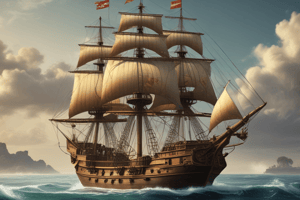Podcast
Questions and Answers
What was one of the primary motivations for European exploration during the period discussed?
What was one of the primary motivations for European exploration during the period discussed?
- To enhance scientific research
- To promote democracy worldwide
- To establish universal education systems
- To claim new territory (correct)
Which economic activity was primarily associated with the Southern colonies?
Which economic activity was primarily associated with the Southern colonies?
- Manufacturing goods
- Fishing and whaling
- Cash crops and plantations (correct)
- Fur trading
What was a significant cultural characteristic of the New England colonies?
What was a significant cultural characteristic of the New England colonies?
- Nomadic lifestyles with scattered settlements
- Centers built around villages and churches (correct)
- Large plantations and farming communities
- Diverse cultures and multiple religions
Which two products were commonly traded from the 13 colonies to Europe?
Which two products were commonly traded from the 13 colonies to Europe?
What was the impact of European exploration on the Native American population?
What was the impact of European exploration on the Native American population?
Flashcards are hidden until you start studying
Study Notes
Reasons for Exploration
- Quest for new sea routes to enhance trade opportunities.
- Search for precious metals like gold and silver, as well as other treasures.
- Desire to claim and expand new territories for European powers.
- French colonial interests in North America centered on lucrative fur trading.
- European expansion led to the spread of diseases that devastated Native American populations.
Trade Routes
- Thirteen Colonies produced rice, tobacco, indigo, furs, rum, iron, and tools.
- Europe exported cloth, manufactured goods, sugar, molasses, and fruit.
- Africa was a source of enslaved persons, gold, and pepper.
- West Indies was a key supplier of sugar and molasses.
Colonial Highlights
- Jamestown was established primarily for tobacco cultivation.
- Plymouth founded by settlers seeking religious freedom.
Three Regional Divisions
New England
- Characterized by the Appalachian Mountains, Boston harbor, and rocky soil.
- Economy based on fishing, whaling, port cities, and fur trading.
- Culture centered around villages and churches.
- Experiences moderate summers and cold winters.
Middle Colonies
- Landscape includes Appalachian Mountains, rivers, harbors, and coastal lowlands.
- Economic activities focused on cattle ranching, grain production, and wheat cultivation.
- Cultural diversity with various religions and a community of merchants and craftsmen.
- Climate features moderate summers and winters.
Southern Colonies
- Dominated by the Appalachian Mountains, Piedmont region, rich soil, and rivers.
- Economy driven by cash crops, large farming operations, and lumbering.
- Culture shaped by the presence of enslaved individuals, scattered settlements, and plantations.
- Climate characterized by hot, humid summers, long growing seasons, and mild winters.
Studying That Suits You
Use AI to generate personalized quizzes and flashcards to suit your learning preferences.




